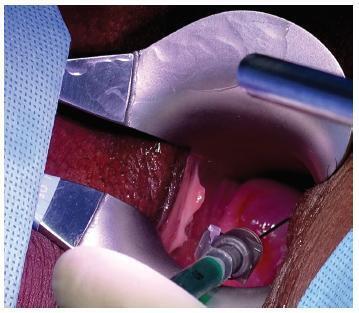Summary
Revista Brasileira de Ginecologia e Obstetrícia. 2017;39(11):632-639
11-01-2017
Axillary web syndrome is characterized as a physical-functional complication that impacts the quality of life of women who have undergone treatment for breast cancer. The present study aims to verify the physiotherapy treatment available for axillary web syndrome after surgery for breast cancer in the context of evidence-based practice. The selection criteria included papers discussing treatment protocols used for axillary web syndrome after treatment for breast cancer. The search was performed in the MEDLINE, Scopus, PEDro and LILACS databases using the terms axillary web syndrome, lymphadenectomy and breast cancer, focusing on women with a previous diagnosis of breast cancer who underwent surgery with lymphadenectomy as part of their treatment. From the 262 studies found, 4 articles that used physiotherapy treatment were selected. The physiotherapy treatment was based on lymphatic drainage, tissue mobilization, stretching and strengthening. The four selected articles had the same outcome: improvement in arm pain and shoulder function and/or dissipation of the axillary cord. Although axillary web syndrome seems to be as frequent and detrimental as other morbidities after cancer treatment, there are few studies on this subject. The publications are even scarcer when considering studies with an interventional approach. Randomized controlled trials are necessary to support the rehabilitation resources for axillary web syndrome.
Summary
Revista Brasileira de Ginecologia e Obstetrícia. 2017;39(1):35-39
01-01-2017
Robotic surgeries for cervical cancer have several advantages compared with lapa-rotomic or laparoscopic surgeries. Robotic single-site surgery has many advantages compared with the multiport approach, but its safety and feasibility are not established in radical oncologic surgeries. We report a case of a Federation of Gynecology and Obstetrics (FIGO) stage IB1 cervical carcinoma whose radical hysterectomy, sentinel lymph node mapping, and lymph node dissection were entirely performed by robotic single-site approach. The patient recovered very well, and was discharged from the hospital within 24 hours.

Summary
Revista Brasileira de Ginecologia e Obstetrícia. 1999;21(1):41-45
03-15-1999
DOI 10.1590/S0100-72031999000100007
Purpose: to demonstrate a new approach to treatment of endometrial cancer. Methods: Between February, 1996 and February, 1998, twelve patients with endometrial cancer, diagnosed by hysteroscopy and biopsy, were submitted to pelvic lymphadenectomy and hysterectomy with salpingo-oophorectomy by laparoscopy. The mean age was 58.1 years, the mean number of gestations was 2.3 and the mean body mass index was 28.6. Results: the mean length of anesthesia was 4.8 hours. The mean time of hospital stay was 3.3 days. The total of lymph nodes obtained was 176, 104 (59.1%) being from the right side and 72 (40.9%) from the left side. The mean of lymph nodes per patient was 18.5. We observed two complications: in one case the laparoscopic procedure had to be abandoned because the patient presented a dangerous increase in intratracheal pressure and in the other case a granuloma in the vagina was observed. Conclusions: the initial evaluation of the laparoscopic hysterectomy and laparoscopy shows that we achieved good results regarding the accuracy of staging, the number of nodes and a small number (3) of complications.
Summary
Revista Brasileira de Ginecologia e Obstetrícia. 2002;24(4):221-226
07-17-2002
DOI 10.1590/S0100-72032002000400002
Purpose: to evaluate the relationdhip between preservation of the intercostobrachial nerve and pain sensitivity of the arm, total time of the surgery, and number of dissected nodes in patients submitted to axillary lymphadenectomy due to breast cancer. Methods: an intervention, prospective, randomized and double-blind study was performed on 85 patients assisted at the State University of Campinas, Brazil, from January 1999 to July 2000. The patients were divided into two groups, according to the intention of preserving or not the intercostobrachial nerve. The surgeries were performed by the same researchers, utilizing the same technique. The postoperative evaluations were performed within 2 days, 40 days and after 3 months. The pain sensitivity of the arm was evaluated through a specific questionnaire (subjective evaluation) and through a neurological physical examination (objective evaluation). Results: the surgical technique was applied to all patients and the preservation of the intercostobrachial nerve was related to a significant decrease in the alterations of pain sensitivity of the arm, both by the subjective and objective evaluations. After three months, in the subjective evaluation, 61% of the patients were asymptomatic in the intercostobrachial nerve preservation group and 28.6% in the nerve section group (p<0.01). By the objective evaluation, 53.7% of the patients presented normal neurological examination in the intercostobrachial nerve preservation group and 16.7% in the nerve section group (p<0.01). No significant difference was observed regarding total time of surgery (p=0.76) and number of dissected nodes between the two evaluated groups (p=0.59). Conclusions: these data show that the preservation of the intercostobrachial nerve is feasible and leads to a significant decrease in the alterations of pain sensitivity of the arm, without interfering in the total time of surgery and the number of dissected nodes.